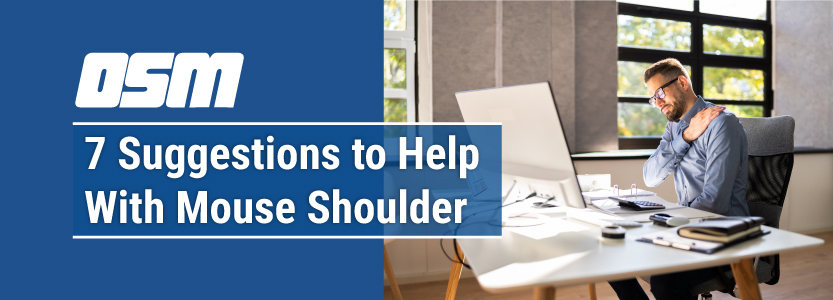7 Suggestions to Help With Mouse Shoulder
Article featured on The Leagrave Therapy Clinic
If you work in an office, you probably spend hours every day with one arm extended on your mouse, clicking and dragging items. Mouse shoulder is a condition that can create shoulder pain from using a mouse with the computer for long periods of time due to poor ergonomics or inappropriate arm or wrist support.
The pain tends to spread over one side of the neck and into the shoulder, it can develop over weeks or months and is often described as a “burning” or deep aching sensation. This repetitive strain injury (RSI) or work-related upper limb disorder can occur from constant repetitive movements in a limited area can lead to real pain problems in the shoulder, neck, and upper back. It may take several weeks or months to develop, but once established Mouse Shoulder can take less than one hour of mouse use a day to maintain this repetitive strain state.
The Canadian Centre for Occupational and Health Safety reports that we actually use our mouses THREE times as often as the keyboard. This repetitive use could occur during work or while playing video games. If you haven’t set up an ergonomic work station, your mouse with relation to your office desk could be positioned too low or too high. It could also be set up in a way where your arm has no or little support during the day.
If your mouse is too low, you’re constantly reaching your hand towards it. Too high and you’re constantly tensing the muscles in your upper arm, shoulder and neck and cause an imbalance of muscle use. With enough time and stress, any area of the body can succumb to a repetitive strain injury (RSI) which is what occurs with mouse shoulder.
How Do l Get Mouse Shoulder?
The shoulder and shoulder blade attach to the body by various muscles that insert into the spine, ribcage, neck and base of the skull. Holding a mouse with the arm held away from the body causes these muscles to contract and become tight, as they support the weight of the outstretched arm. Sitting like this for several hours with little variation or relaxation can lead to pain and weakness over time.
What can be done to help
Mouse Shoulder responds well to a combination of anti-inflammatory drugs (NSAIDs) and manual treatment. In acute cases medical acupuncture can reduce the severe pain and muscle spasm by treating the painful trigger points.
However, treatment alone is not the answer. Without any modification to work posture or lifestyle these symptoms will return within days or weeks. You are then at risk of becoming dependent on repeated, costly and long-term treatment.
7 Ways To Help Yourself
- Become ‘ambi-moustrous’: learn to use the mouse with BOTH hands. This is a difficult skill to learn and will need to be practised little and often each day. Alternatively, learn to hold the mouse closer to your side and remember to drop the shoulder down.
- Change your mouse to a Trackball or marble mouse and bring it closer to you. Research has shown that holding the mouse with the arm less than 10° abducted from the body can reduces the muscle activity by a factor of 25-60%.
- One of the most important things to remember about Repetitive Strain Injuries is the word REPETITIVE. Add as much variety as you can to your desk and work practice. Share different designs of mouse between members of your office; swap them around every week or so, to add to the variety.
- Get up and move about regularly. If possible, rather than emailing or telephoning someone else in your office – go and talk to them in person.
- Activities such as racket sports, swimming, Pilates, archery or bell ringing, will exercise the upper back muscles.
- Use a resistance band (Theraband) to exercise upper back muscles for 2-3 minutes, 2-4 times a day. Building up the upper back and neck muscles will help improve your neck support and encourage a better posture.
- Self massage; A tennis ball in a sock makes a good, cheap alternative to expensive self-massagers.
The Orthopedic & Sports Medicine Center of Oregon is an award-winning, board-certified orthopedic group located in downtown Portland Oregon. We utilize both surgical and nonsurgical means to treat musculoskeletal trauma, spine diseases, foot and ankle conditions, sports injuries, degenerative diseases, infections, tumors and congenital disorders.
Our mission is to return our patients back to pain-free mobility and full strength as quickly and painlessly as possible using both surgical and non-surgical orthopedic procedures.
Our expert physicians provide leading-edge, comprehensive care in the diagnosis and treatment of orthopedic conditions, including total joint replacement and sports medicine. We apply the latest state-of-the-art techniques in order to return our patients to their active lifestyle.
If you’re looking for compassionate, expert orthopedic and podiatric surgeons in Portland Oregon, contact OSM today.
Phone:
Address
17355 Lower Boones Ferry Rd Suite 100A
Lake Oswego, OR 97035
Hours
Monday–Friday
8:00am – 4:30pm



